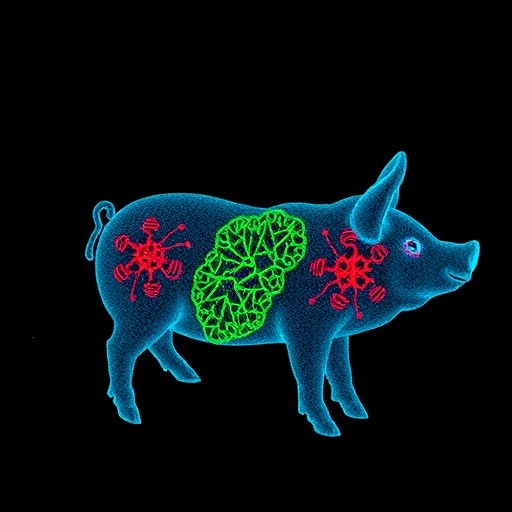In a groundbreaking study that promises to reshape our understanding of mammalian reproductive biology, researchers have delved deep into the intricacies of pig testis development following birth using innovative single-cell analysis techniques. The study, led by Wang et al., sheds light on the complex cellular composition of postnatal testicular tissues, offering insights that could inform both veterinary practices and agricultural improvements.
The research marks a significant advancement in the field of genomics, specifically concerning the insights drawn from single-cell sequencing technologies. These methods allow scientists to examine the genetic blueprint of individual cells rather than bulk samples, revealing unique cellular identities and their corresponding roles in development. This approach has unveiled a rich tapestry of cellular diversity that was previously obscured in analyses conducted on larger sample sizes, fundamentally altering our understanding of testicular development in pigs.
At the heart of this study lies the examination of germ and somatic cell populations within the testes, which play critical roles in spermatogenesis and hormonal regulation. Through meticulous isolation and characterization of these cells, the research team was able to identify novel markers that differentiate various cell types. By linking these markers to specific functions and developmental stages, the researchers have established a comprehensive map detailing the cellular dynamics at play throughout postnatal testis development.
The implications of this research extend far beyond the academic realm. Understanding the molecular features of testis development in pigs could have profound consequences for the swine industry. For instance, farmers could benefit from improved breeding strategies based on enhanced knowledge of fertility mechanisms and developmental anomalies. Such advancements could lead to healthier livestock and, ultimately, more productive farming operations.
Moreover, the findings of this study resonate with broader biological principles. The cellular heterogeneity observed in pig testis development serves as a model that could be extrapolated to other species, including humans. Insights gained from porcine models may offer critical information about male reproductive health, particularly in terms of understanding fertility disorders and testicular diseases that are prevalent in human populations.
As the researchers continue to analyze the vast amounts of data generated from their single-cell analyses, they are encouraged by the potential for future discoveries. The study not only highlights the importance of cell-resolved genomic approaches in developmental biology but also sets the stage for further explorations into the cellular mechanisms governing reproductive health across species.
In addition to the direct applications in agriculture and medical science, this research contributes to a more extensive body of literature which connects developmental biology to evolutionary processes. By scrutinizing the developmental pathways and molecular features in pigs, scientists can gain insights into the evolutionary adaptations that shape reproductive strategies across mammals.
The technological advancements in single-cell analysis have significantly transformed the landscape of genetic research, providing an unprecedented level of resolution that uncovers the cellular intricacies within tissues. This study leverages state-of-the-art sequencing technologies to dissect the postnatal development of pig testis, establishing a new paradigm in our comprehension of organogenesis.
The researchers were particularly intrigued by the interplay of various signaling pathways and gene expression patterns they discovered during their analyses. They identified key transcription factors that drive the differentiation of spermatogonial stem cells, which are critical for the production of sperm. By highlighting these connections, the study lays the foundation for future research aimed at manipulating these pathways to improve reproductive outcomes in livestock.
Furthermore, the study raises questions about the environmental and genetic factors influencing testicular development. The pursuit of knowledge in this area could lead to significant breakthroughs in addressing infertility and related issues in both animals and humans, thereby contributing to global health problems.
In conclusion, the work conducted by Wang et al. serves as a pioneering contribution to the field of reproductive biology, enhancing our understanding of the molecular complexities underlying testis development. As researchers continue to tease apart the genetic and environmental interactions influencing cell differentiation and development, we are reminded of the dynamic nature of life and the intricate processes that govern our biology.
This study not only enriches our understanding of pig development but also prompts a re-evaluation of how we study and think about reproduction in a broader sense. The journey from initial embryological development to fully functional reproductive organs is indeed an intricate one, and thanks to technologies like single-cell analysis, we are better equipped to unravel its mysteries.
With the potential to transform agricultural practices and enhance human health outcomes, this work illustrates the necessity of ongoing research in reproductive science. As we anticipate the implications of these findings, it also beckons further inquiries, exploration, and excitement within the scientific community.
As new methodologies and technologies continue to emerge, the collaborative efforts among biologists, geneticists, and industry practitioners will undoubtedly yield further insights that could benefit both science and agriculture alike. The exploration of cellular heterogeneity will shape not only future research directions but also the answers to longstanding questions in various domains of biology.
As we stand on the cusp of these exciting discoveries, it becomes increasingly clear that the cellular world is more nuanced than we ever imagined. The ability to visualize and understand the complexity of tissue development opens up a landscape full of opportunities for innovation and advancement.
Therefore, as we reflect on the findings of Wang et al., we find ourselves at a pivotal moment in reproductive biology that could pave the way for transformative discoveries in the years to come. The future is undoubtedly bright as we deepen our understanding of the often-unseen incredible intricacies of life, one cell at a time.
Subject of Research: Pig testis development and cellular heterogeneity.
Article Title: Single-cell analysis reveals cellular heterogeneity and molecular features during postnatal pig testis development.
Article References:
Wang, L., Ao, H., Liu, H. et al. Single-cell analysis reveals cellular heterogeneity and molecular features during postnatal pig testis development.
BMC Genomics (2025). https://doi.org/10.1186/s12864-025-12280-8
Image Credits: AI Generated
DOI: 10.1186/s12864-025-12280-8
Keywords: Pig testis development, single-cell analysis, cellular heterogeneity, spermatogenesis, reproductive biology.




